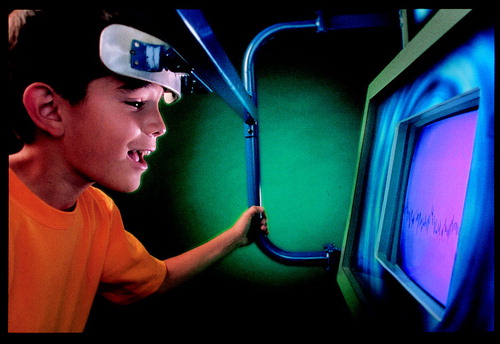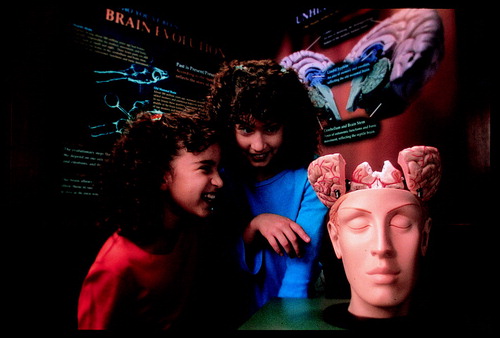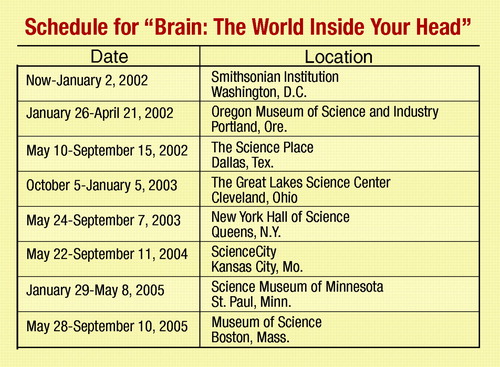Exhibition Makes It Easy, Fun To Venture Inside Brain
 Children can climb off the carousel on the National Mall in Washington, D.C., walk a few hundred yards, and find adventures of an entirely different kind.
Children can climb off the carousel on the National Mall in Washington, D.C., walk a few hundred yards, and find adventures of an entirely different kind.
“Brain: The World Inside Your Head,” at the Smithsonian Institution’s Arts and Industries Building through January 2, 2002, offers more than 5,000 square feet of interactive exhibits that delve into everything from neurons to brain chemicals, dreams to language development, and depression to Alzheimer’s disease. They were designed to help children understand how the brain works and why it sometimes malfunctions.
The effort, which was made possible by a grant from Pfizer Inc., was produced in collaboration with the National Institutes of Health (NIH).
Ruth Kirschstein, M.D., acting NIH director, lauded the exhibition. “[It] will provide a firsthand opportunity for millions of adults and children across the country to learn and understand more about the brain, one of science’s most exciting and challenging fields of research.”
“Brain” will travel to 15 science and natural history museums throughout the country (see box). A virtual tour is available at www.pfizer.com/brain.
The next stop is the Oregon Museum of Science in Portland, where the exhibition will open on January 26.
 Those who have an opportunity for a real tour of the exhibition will be able to crank open a model of the head to reveal the cortex, limbic system, brain stem, and cerebellum. They can also lean on electrodes and perform tasks to see a simulation of real-time EEG. A computer simulation of brain surgery enables children to locate a tumor using a simulated gamma knife and deliver a dose of radiation to the correct area inside the brain.
Those who have an opportunity for a real tour of the exhibition will be able to crank open a model of the head to reveal the cortex, limbic system, brain stem, and cerebellum. They can also lean on electrodes and perform tasks to see a simulation of real-time EEG. A computer simulation of brain surgery enables children to locate a tumor using a simulated gamma knife and deliver a dose of radiation to the correct area inside the brain.
The “synapse pop” interaction demonstrates how a synapse makes the connection between neurons. Children release a signal ball, which travels down a tunnel. At the end of the tunnel is a gap between neurons, a synapse. The ball disappears and sets off a light show, imitating the action of an electrical signal traveling between neurons.
According to a recent Pfizer survey, 38 percent of American adults said they have a family member with a brain-related disorder. Only 16 percent of the parents, however, said that they had “very thoroughly discussed” mental illness with their children. Many more parents had “very thoroughly” discussed underage alcohol use (64 percent) and illegal drugs (69 percent) with their children.
Exhibition planners aimed to address this need for information about brain dysfunction, as well as providing children an entertaining way to get acquainted with the body’s most essential organ.
The exhibition offers the story of railroad worker Phineas Gage to demonstrate how personality can be affected by physical changes in the brain. In 1848 an explosion rocketed an iron rod through Gage’s cheek and part of his brain. Gage’s personality changed from kind and cheerful to lazy and quarrelsome. His doctor, John Harlow, M.D., suspected that the change in the railroader’s personality had been caused by damage to the frontal lobes of his brain.
Harlow’s speculation was proved correct in the early 1990s, when a University of Iowa team decided to find out what caused Gage’s personality changes. By examining his skull with modern imaging and computer techniques, they performed a “virtual autopsy.” When the researchers compared the data with those from patients with similar personality changes, they discovered similar brain damage.
Cathryn Clary, M.D., M.B.A., senior medical director and worldwide team leader for depression and anxiety at Pfizer, and advisor on the exhibition, told Psychiatric News, “I remember so well going to visit the large walk-in mechanical heart at the Franklin Institute in Philadelphia years ago and how it made heart mechanics come alive. I hope our exhibition will do the same thing for the brain.”
A section at the end of the exhibition contains pamphlets and other kinds of information about various brain disorders published by the national institutes of Mental Health, Drug Abuse, and Neurological Disorders and Stroke. Through the American Academy of Child and Adolescent Psychiatry, Pfizer developed a guide for parents, “Talking to Kids About Brain-Related Conditions.” It is available free by calling (800) 882-3718 or can be downloaded from the Web site listed above.
Clary said, “If children can learn about brain disorders and view them just as they would a heart or a stomach disorder, then we will go a long way toward empowering sufferers of these devastating disorders to talk with their doctors and seek the treatment they need without being ashamed.”
More information on the exhibit is posted on the Smithsonian Institution’s Web site at www.si.edu/activity/exhibits/ai.htm and at the exhibit’s site at www.pfizer.com/brain/. Information about the brain and programs related to the brain is posted on the Smithsonian site at http://residentassociates.si.edu/rap/idx-brain.asp. ▪



